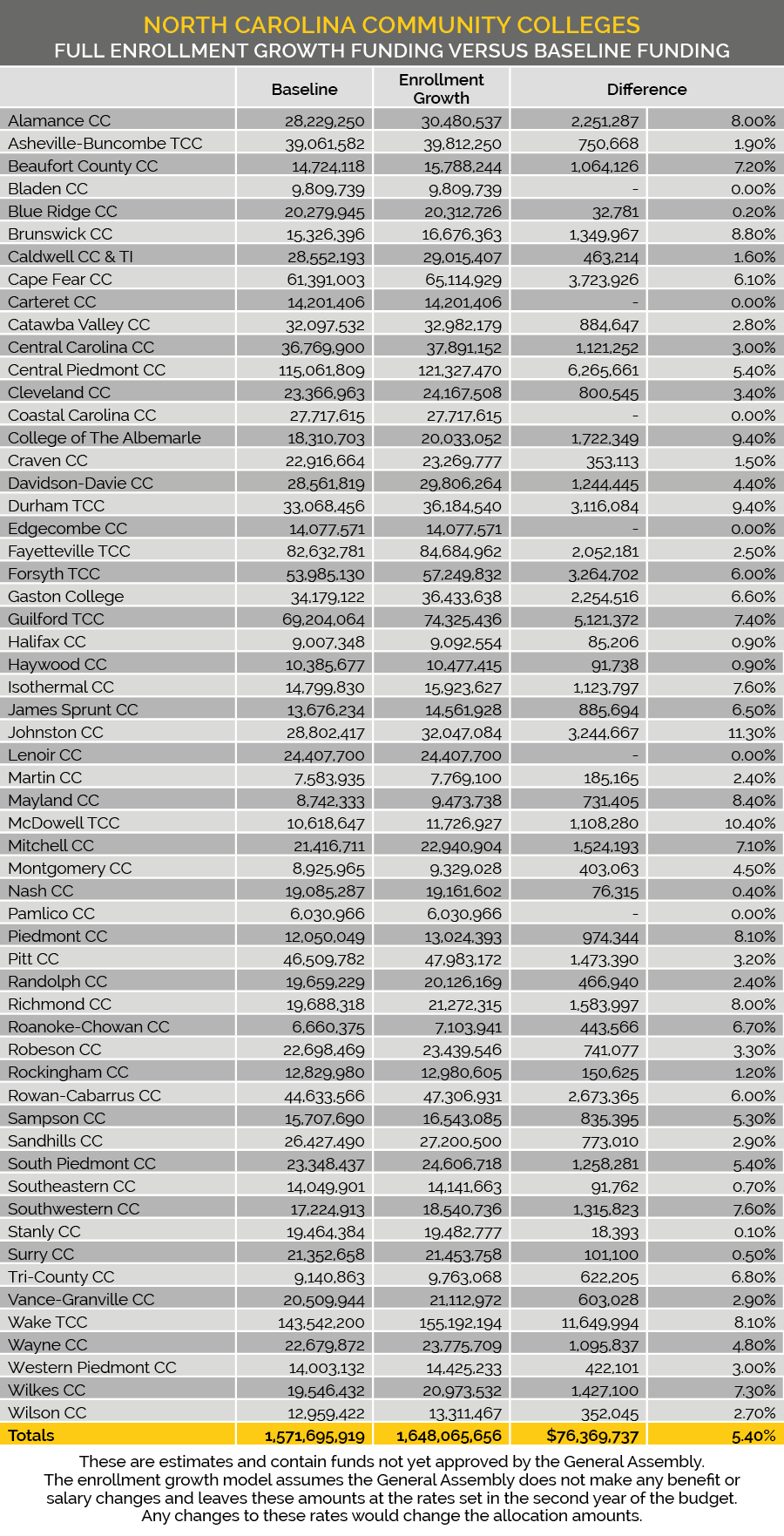Derelict
Published August 22, 2024
There’s no reason North Carolina’s community colleges should be staring at budget deficits when the state is sitting on a billion-dollar surplus.
Yet they are.
And it’s community-college students – the ones working to better their place in the world – who will pay the price.
That’s not right.
“The classes will not be offered that they’re looking for in the volume that they’re looking for, in the short term,” said Scott Ralls, President of Wake Technical Community College and a former President of the NC Community College System.
“You can’t outrun your budget.”
COMMUNITY COLLEGES in North Carolina get state funds based on the previous year’s enrollment. (As do public universities.)
So in February, the State Board of Community Colleges asked the General Assembly to provide an added $69 million based on 4.6% growth in students in 2023-24.
But in a standoff over whether to further increase pay for K-12 teachers and state employees, the General Assembly adjourned in June without updating the second year of the state’s 2023-25 budget.
So incredibly, while the state sits on a $1.4 billion budget surplus, community colleges face deficits for 2024-25 after a year of what System President Jeff Cox called “robust” growth in enrollment.
And colleges see more students enrolling this fall.
“The deficit is so much more than we’ve ever encountered,” Cox told the State Board of Community Colleges last week.
“You can’t adjust with money you don’t have,” said Lisa Estes, chair of the State Board’s finance committee.1
The growth is statewide, at urban, suburban and rural colleges.
Johnston Community College had the biggest percentage increase in students last year, at 11.3%, which would warrant an additional $3.2 million in state funds. McDowell Tech was second, with 10.4% growth worth $1.1 million. Durham Tech was third, with 9.4% growth that would require $3.1 million. The legislature’s inaction cost Wake Tech, with 8.1% growth, $11.6 million.2
THIS IS JUST the latest example of how state legislators abdicated their duty when they adjourned their session in June without updating the state budget.
It’s absurd. And it’s irresponsible – another symptom of a dysfunctional legislature.
Legislators need to do what we elected them to do and provide funds for those students who are bootstrapping their way to an education – students who are arguably the most economically fragile in higher education.
At a time when the state is pushing community colleges to strategically expand to prepare North Carolinians for skilled jobs, legislators are derelict in their own jobs.
WHAT DOES THIS MEAN FOR STUDENTS?
At Johnston Community College, President Vern Lindquist expects enrollment to grow even more this fall, with 26% growth in students over two years.
“I’ve been calling some of my president friends around the country, asking, ‘What does one do? What is the playbook?’” Lindquist said.
There isn’t one.
“Somehow I have to hire more staff and more faculty,” Lindquist said.
It could mean larger classes, though Lindquist said many of his classes are already at capacity. At small colleges, he said, a shortfall of even $100,000 can mean an inability to hire key instructors.
It means financial-aid processing will be slower – a critical factor in student access, especially given the U.S. Department of Education’s botched rollout of new applications for aid.
“It’s longer wait times for everybody, where they’re just not getting the services they deserve,” he said.
At Durham Tech, President J.B. Buxton said he is working to provide for 9% more students who enrolled last year and 5-7% more this fall.
“When we’re down $3.1 million from where we need to be and dealing with an additional 7%, there’s nowhere to go,” he said.
Buxton said he’s holding off on non-academic hires and purchases of equipment in areas like nursing and the skilled trades.
“We don’t want to do that, but we have to do that,” he said.
Ralls oversees the state’s largest community college at Wake Tech, with nearly 33,000 degree-seeking students.
Partly due to a post-Covid bounceback, he says the Community College System is seeing its strongest, broadest growth in enrollment in at least 15 years. Fifty-four of the state’s 58 colleges saw enrollment grow last year, and Ralls said Wake Tech is seeing even stronger growth this fall.
Yet colleges are “idling,” he said.
“We can’t expand right now,” he said. “We’re not expanding … because we can’t predict that future.”
Ralls and Buxton both said they don’t think the damage to community colleges is intentional – the colleges are collateral damage in legislative wars over K-12 teacher pay, medical marijuana and the like.
COME NOVEMBER, though, presidents must decide on colleges’ offerings for spring.
If Durham Tech goes without two years of enrollment growth funds, said Buxton, “Then I’m figuring out which programs we cut … which adjunct instructors we don’t bring back.
“Then we’re talking about people and programs.”
This is wrong. Wrong for North Carolina. Wrong for its economy. And most of all, wrong for students who are doing what we want them to do.
State legislators need to return to Raleigh and do the job we sent them there to do.
And we need to remember this in November.
1 https://www.ednc.org/08-19-2024-state-board-discusses-strategies-to-shorten-degree-completion-time-for-adult-learners/.
2 https://www.ednc.org/wp-content/uploads/2024/08/EdNC-Enrollment-Growth-Sheet.pdf.








